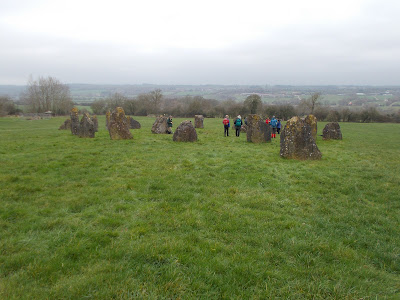The Concise Oxford Dictionary of Archaeology defines a stone circle as "a setting of upright stone pillars forming a ring whose exact ground plan many vary between being almost exactly circular through to elliptical or egg‐shaped". Ancient stone circles date from the late Neolithic through to the early Bronze Age and many of them are the final phase in the development of a monument, which started as a timber circle. They are located in western parts of the British Isles, northern France and Scandinavia.
Ancient stone circles are not common in Somerset (e.g. Withypool Hill and Stanton Drew). However there are several modern ones e.g. at Ham Hill, Pilton (Glastonbury Festival site) and Ashill.
Stanton Drew
The three stone circles and three stone "cove" at Stanton Drew to the east of Chew Magna, make up the third largest complex of prehistoric standing stones in England. The Great Circle, which is 113 metres in diameter and has 26 surviving upright stones, is one of the largest stone circles in England. There are two smaller stone circles: to the south west and north east of the Great Circle. The Cove, which consists of three large stones, is located in the garden of the Druid's Arms pub. Across the River Chew to the north of the stone circles is a single standing stone known as Hautville's Quoit. The Cove, stone circles and Hautville's Quoit were almost certainly parts of a single complex.
According to legend, the Stanton Drew Stone Circles are the petrified remains of a group of wedding guests and the musicians who were entertaining them: they were lured by the devil into celebrating on a Sunday and they were punished for doing so by being turned into stone.
Withypool Hill
The stone circle on the south west side of Withypool Hill is visually underwhelming, as the stones are not very large (the tallest one is only 50cm high). There are 27 surviving stones and 3 fallen ones and the diameter of the circle is 36 metres. The circle may originally have consisted of up to 100 stones. It was first identified in 1898 and was recorded in 1906 by Harold St George Gray. Grid reference: SS 838 343.
Ham Hill
This modern stone circle consists of 15 standing stones made of the local Hamstone. It was erected as a Millennium project to commemorate the many centuries of quarrying that have gone on at Ham Hill and all the men who have worked there. Pieces of shell and other small fossils can be seen in the stones. Grid reference: ST 478 171.
Glastonbury Festival, Worthy Farm, Pilton
This stone circle is located in King's Meadow on the southern edge of the Glastonbury Festival site at Worthy Farm, Pilton. It consists of 20 large stones and was erected in 6 weeks in 1992. It is known as the Swan Circle, after the constellation Cygnus (it is egg shaped). Ivan McBeth constructed it using local limestone quarried from the nearby Torr Works Quarry. Each stone was individually chosen by Ivan and Michael Eavis. Ivan McBeth, who was a Druid, later constructed a number of other stone circles for private clients at various locations across England and also in the USA, Canada and Australia before his death in 2016. The Swan Circle is located on private land and is normally only accessible during the Glastonbury Festival. We were given permission to walk around the empty site in February 2019. The grid reference for the Swan Circle is ST590 397.
Glastonbury - Street Road
As you drive into Glastonbury on the A39 coming from the south, there is a small modern stone circle in what may be a private garden but it is clearly visible on the right hand side of the road opposite the Red Brick Building.
Ashill
There is a small stone circle located on a public footpath, 400 metres west of the parish church. It is in a field, which also has 5 life size white statues of ladies in various states of undress, so I presume they all belong to the same person.
Ham Hill
Ham Hill
Withypool Hill
Withypool Hill
Withypool Hill
The Great Circle, Stanton Drew
The Great Circle, Stanton Drew
The Cove, Stanton Drew
The Cove, Stanton Drew
Ashill
Ashill
Swan Circle, Glastonbury Festival Site
Swan, Circle, Glastonbury Festival Site
Glastonbury Festival Site
Centre of the Swan Circle, Pilton
Stone Circle, Street Road, Glastonbury
Stone Circle, Glastonbury
Stone Circle, A39 Glastonbury



















